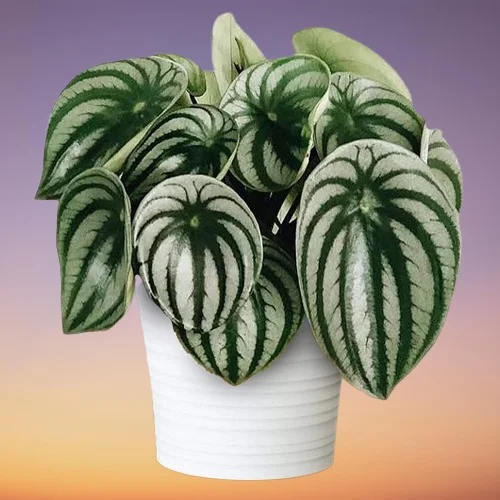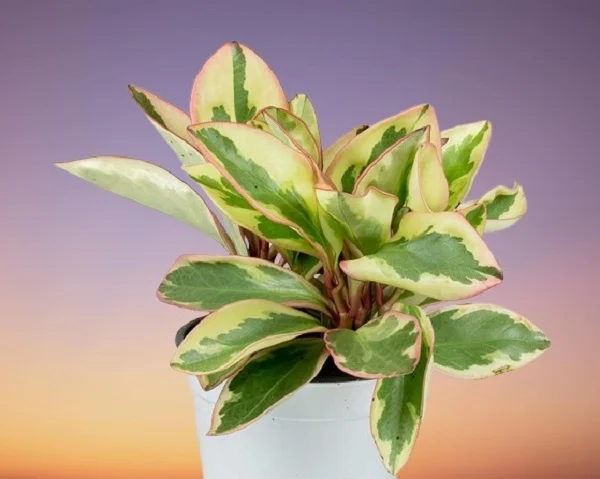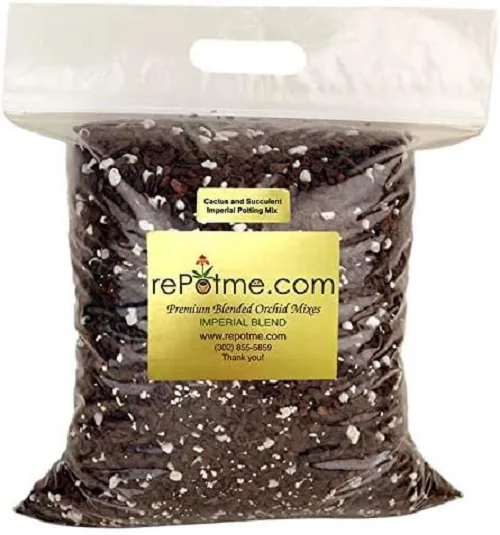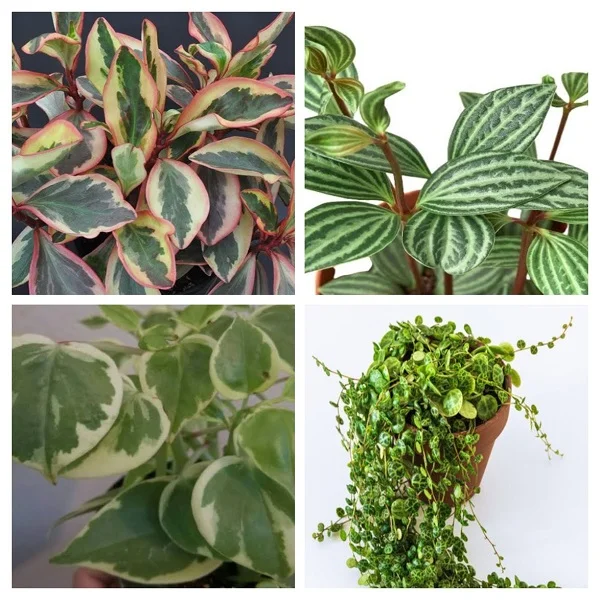Peperomia (Radiator Plants) Indoor Care and Common Problems with Remedies
Some links in this post may be affiliate links
Peperomia (Radiator Plants) thrive in medium to bright indirect light, warm and humid conditions, and moderately moist, rich, well-drained soil coupled with regular feeding in the growing season.
Peperomia are easy-care plants which come in a variety of beautiful foliage, texture and growth habits which qualify them for any houseplant collection.
Peperomia is one of the two genera in the Piperaceae famliy (the Pepper family) which comprises of about 3600 species. The genus name Peperomia was coined by Spanish botanists Ruiz López and Pavón Jiménez in 1794 after their travels in Peru and Chile.
The common name, 'Radiator Plants', is thought be have been coined by L.H. Bailey because many of these plants enjoy bright and dry environments similar to a windowsill above a radiator.
There exists numerous varieties of Peperomia; trailing, bushy and upright ones are available. The foliage may be fleshy, quilted, corrugated, smooth or hairy, green or variegated or even striped like a watermelon.
Some of the popular Peperomia varieties for indoors include Watermelon Peperomia, Emerald Ripple Peperomia, Baby Rubber Plant, Beetle Peperomia, and Red Log Peperomia.

Origin
Peperomia are found occurring in all tropical and subtropical regions of the world but being concentrated in northern South America and Central America, but are also found in Africa, southern Asia, and Oceania. They are some of the best tropical foliage plants ideal for the home, office and other spaces.
Flower
Peperomia flowers are usually unnoticeable, rat-tail flower-heads made up of greeninsh flowers on an upright spike. Most peperomia flowers may be odorless to humans but some carry a musty or even unpleasant odor.
Are Peperomia toxic?
No. Peperomia are non-toxic to humans and pets. Radiator Plants are safe for cats, dogs and other pets in the home.
Where to Buy
If you are looking to acquire Peperomia for your collection, you may obtain these plants online from Amazon (Link to Amazon).
How to care for Peperomia indoors
To care for Peperomia (Radiator Plants) indoors, provide medium to bright indirect light, average warmth of 15-260C, humidity of 60-80% and moderately moist, rich, well-drained soil coupled with regular feeding in spring and summer. Keep reading for a detailed account on the best growing conditions for these plants.

Watering
How often should I water Peperomia?
Water Peperomia liberally in spring and summer while allowing the top few inches of soil to dry out between waterings. Keep the soil moist and avoid overwatering to prevent rotting, wilting, yellowing and leaf drop.
Cut down on watering in fall and winter to keep the soil slightly moist soil as growth as slowed at this time. However, do not allow the soil to dry out completely to prevent wilting, drooping, yellowing and leaf drop.
Use water that is at room temperature to avoid cold shock which can cause stunted growth and leaf drop. Ascertain that the water is chemical free to prevent browning of edges and leaf tips.
Ensure that the pot has a drainage hole and the soil is well-draining to prevent it from getting soggy as it can lead in root-rot and death of the plant.
Be careful not to wet the foliage to minimize fungal diseases like leaf spot, powdery mildew and others.
Light Requirements
Do Radiator Plants like sun or shade?
Radiator Plants like medium to bright indirect light (filtered light). Put it near a large, brightly-lit window away from direct sunshine to prevent scorching of the leaves.
Make sure that the plant gets adequate light as too little light will result in leggy plants and loss of leaf color. If the natural lighting is not enough, consider using full spectrum grow lights to supplement it.
Rotate the pot regularly to ensure that the plant receives light on all sides for uniform growth as well as prevent leggy growth.
Temperature & Humidity
Peperomia grow best in average warmth of 15-260C; a room temperature that is comfortable for you is ideal for these plants.
Keep them away from sources of drafts like AC units, hot air vents, stoves, windy doors, drafty windows and others. The drafts cause sudden temperature changes which can result in reduced growth, yellowing and leaf fall.
Radiator Plants flourish in humidity 50-80%; too low humidity may result in brown leaf tips and edges. If the air is too dry, set pot on a wet pebble tray or use a humidifier to heighten humidity. Ensure that there is good air circulation to prevent fungal diseases.
You may grow the moisture-loving varieties in a well-lit bathroom or in a closed terrarium where a high humidity can be maintained.
Fertilizer
What is the best fertilizer for Peperomia?
Peperomia are not heavy feeders, therefore, feed with a balanced, liquid fertilizer monthly in spring and summer.
Do not feed in the cold season as growth is reduced at this time and feeding at this time may lead to fertilizer burn and eventual death of the plant.
Every 1-2 months, leach out accumulated salts by running a stream of water through the soil until it comes out through the drainage hole. Let it run for about 5-10 minutes.
Potting Soil
What kind of soil does a Peperomia need?
Peperomia need an airly, well-drained soil that is rich in organic mater that does not become soggy. Cactus and succulents soils are ideal for the succulent varieties while the all purpose potting mixes are great for non-succulent plants.
Repotting
Peperomia are slow-growing plants and may not require regular repotting. Repot them during the growing season (spring and summer), only when the plant has become pot-bound.
Select a pot one size larger than the current one to avoid over potting the plant. Ensure the pot has a drainage hole and the soil is free-draing to prevent root-rot and eventual death of the plant.
The succulent Peperomia require that the soil should drain out faster. Therefore, terracoat pots are preferable for these succulents. Take a look at these terracotta pots with saucer on Amazon.
Pruning & Grooming
Pruning Peperomia involves regular removal of dead foliage to maintain the plant neat as well as minimize pest and disease infestations.
To encourage a fuller, bushy growth, regularly pinch off the growing tips; snip the tips at a point just above a leaf node.
As the plant ages, it becomes straggly, therefore, cutback the stems during the growing season to rejuvenate growth
Occasionally clean the leaves by damp-wiping with a soft cloth to get rid of dust and also discourage pest and disease infestations.
Peperomia Propagation
Peperomia (Radiator Plants) are best propagated from leaf and stem cuttings or by division in spring to early summer when in active growth.
Learn how to propagate Peperomia (Radiator Plants) by 5 methods.

Peperomia Problems & Solutions
Peperomia problems are dropping leaves, drooping leaves, yellow leaves, brown leaves, curling leaves, plant dying, brown leaf tips, diseases and pests among others. Below is a detailed account on these problems and how to fix them.
Dropping leaves
Why do Peperomia leaves fall off?
Peperomia leaves falling off or drop off due to inconsistent watering, soggy soil, too little light, temperature stress, use of cold water among others.
How to fix it
Inconsistent watering: Water when the top few inches of soil dry out but never allow the soil to dry out completely. Do not water on a schedule.
Soggy soil: Pot the plant in a pot with a drainage hole and loose, well-draining soil.
Insufficient light: Place the plant in medium to bright indirect light or use a grow light if the natural light is not enough.
Temperature stress: Keep the plant away from drafts coming from AC units, heat sources, windy doors, drafty windows among others to maintain an average warmth.
Use of cold water: Water the plant with water that is at room temperature to prevent cold shock.
Check out these 12 reasons why Peperomia is dropping leaves and their solutions.
Drooping leaves
Why are my Peperomia leaves drooping?
Drooping leaves on your Peperomia are caused by direct sunlight, dry air, extreme temperatures, incorrect watering, pests infestations among others.
How to fix it
Direct sunlight: Keep the plant away from direct sunlight or use a light curtain to filter it out.
Dry air: Set the pot on a wet pebble tray, use a humidifier or group the plants together to increase humidity.
Extreme temperatures: Keep the plant away from sources of drafts like hot air vents, AC units, stoves, windy doors and windows among others.
Incorrect watering: Water when the top few inches of soil dry out and do not allow the soil to dry out completely. Do not water on a schedule.
Pests infestations: Regularly check underneath and between the leaves for these pests and carry out timely control measures.
Take a look at these 14 causes of Peperomia drooping leaves and how to fix them.
Yellow leaves
Why are the leaves on my Peperomia turning yellow?
Some of the causes of yellow leaves on your Peperomia are inconsistent watering, soggy soil, nutrients deficiency or too little light.
How to fix it
Inconsistent watering: Water when the top few inches of soil feel dry but do not allow the soilball to dry out completely. Do not water on a schedule.
Soggy soil: Use a pot with a drainage hole and well-draining soil.
Nutrients deficiency: Feed the plant with a balanced, water-soluble fertilizer every 4 weeks in spring and summer.
Too little light: Place the plant in a brighter spot or use a grow light is the natural light is not adequate.
Brown leaves
Why are my Peperomia leaves turning brown and falling off?
The main causes of brown leaves on your Peperomia are incorrect watering, soggy soil, too little light, extreme temperatures or aging.
How to fix it
Incorrect watering: Water when the top few inches feel dry but do not let the soilball dry out completely.
Soggy soil: Ensure that the soil drains freely and that the pot has a drainage hole.
Too little light: Position the plant in a brighter spot with medium to bright indirect light.
Extreme temperatures: Protect the plant from drafts coming from hot surfaces, AC units, windy doors, drafty windows and others.
Aging: With maturity the older leaves begin to die; they first turn yellow, then brown and eventually fall off.
Curling leaves
What causes Peperomia leaves to curl?
Curling leaves on Peperomia are caused by inconsistent watering, soggy soil, drafts, dry air, being pot-bound.
How to fix it
Inconsistent watering: Water when the top few inches of soil feel dry but never allow the soil ball to dry out completely. Do not water on a schedule.
Soggy soil: Use a pot with a drainage hole and loose, well-draining soil.
Drafts: Keep the plant away from drafts coming from AC units, heat sources, windy doors, drafty windows, hot air vents among others.
Dry air: To raise humidity, set the pot on a wet pebble tray, use a humidifier or group the plants together.
Being pot-bound: Repot the plant into a pot one size larger when it becomes root-bound.
Plant dying
Why is my Peperomia suddenly dying?
Your Peperomia is dying due to inconsistent watering, temperature stress, nutrients deficiency, low humidity, pests infestations or root-rot.
How to fix it
Inconsistent watering Water when the top few inches of soil dry out but do not allow the soil to dry out completely. Do not water on a schedule.
Temperature stress: Keep the plant away from drafts emanating from AC units, heat sources, windy doors, drafty windows, hot stoves among others.
Nutrients deficiency: Fertilize with a balanced, liquid fertilizer every 4 weeks in spring and summer.
Low humidity: To increase humidity, set the pot on a wet pebble tray or use a humidifier.
Pests infestations: Regularly inspect the plant for pests and carry out timely control measures.
Root-rot: Carry out timely control measures as outlined herebelow under the title, 'diseases'.
Brown leaf tips and edges
Brown leaf tips and edges on Parallel Peperomia are due to cold drafts, dry air and salts buildup.
How to fix it
Remove all the damaged leaves to keep the plant neat and tidy.
Cold drafts: Keep the plant away from cold drafts emanating from windy doors, drafty windows, AC units among others.
Dry air: Set the pot on wet pebble tray or use a humidifier to raise humidity. You may grow the plant in a well-lit bathroom and other humid places in the home.
Salts buildup: Flush out the salts from the soil every 1-2 months by running a stream of water through the soil until it comes out through the drainage holes.
Diseases
What diseases are common to Peperomia?
Peperomia are prone to the following diseases:
1. Leaf spot disease which is enhanced by damp, stuffy conditions. It presents as brown, soft leaf spots.
How to fix it
- Isolate the affected plant and treat it with horticultural oil as per the manufacturer's instructions.
- Avoid wetting the leaves during watering to minimize the disease infestation; water from the bottom instead.
- Improve the air flow for the plant to discourage the disease.
2. Root-rot disease which is prevalent in soggy soil and is characterized by rotting, yellow, lead drop and sudden collapse of the plant.
How to fix it
- Carefully slip the plant out of its pot and inspect the roots.
- Trim the brown-black, mushy roots and treat the healthy roots with a copper-based fungicidal solution as indicated on the label.
- Disinfect the pot with the fungicidal solution or use a fresh pot to repot the plant in fresh, well-draining soil.
- Do not water the plant immediately and keep it dry for 5-7 days before you can resume watering.
- Use a pot with a drainage hole and well-draining soil to prevent the soil from getting soggy.
- Decrease watering in fall and winter as growth is slowed at this time; keep the soil slightly moist.
Pests
Which pests are common to Peperomia?
Common pests on Peperomia Plants are spider mites, whiteflies, scale insects and mealybugs.
How to fix it
- Isolate the affected plant to prevent spread to other plants.
- Treat the infested plant with insecticidal soap as per the manufacturer's recommendations.
- Regularly, check between and underneath the leaves for these pests and carry out timely control measures.
- Keep the plant well pruned to depress the pest infestations.
You liked it? Share on social media.
Related Content
Amazon Associates Disclosure
Homeplantsguide.com is a participant in the Amazon Services LLC Associates Program, an affiliate advertising program designed to provide a means for sites to earn advertising fees by advertising and linking to amazon.com.





